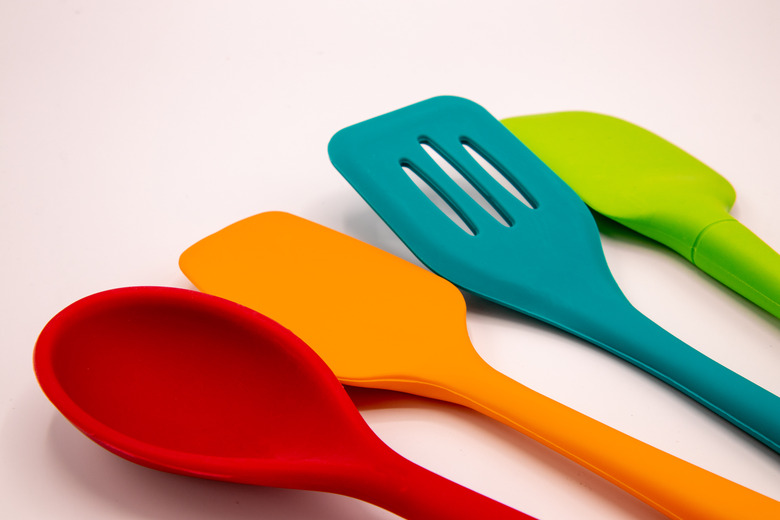The Dangers Of Nylon Kitchen Utensils
We may receive a commission on purchases made from links.
The dangers of nylon kitchen utensils are relatively modest, which — along with their low cost and the fact that they play nicely with nonstick surfaces — accounts for much of their popularity. That being said, they do pose a few modest hazards. Safety- and health-conscious buyers might want to keep those in mind when choosing kitchen utensils.
Dangers of Nylon Kitchen Utensils
Dangers of Nylon Kitchen Utensils
The most immediate of those dangers revolves around the melting point of the nylon (or polyamide if you're a chemist) used in most kitchen utensils. The types used for kitchen utensils are polyamides 6 and 66 (usually abbreviated as P6 and P66 respectively). They're valued for utensil-making because they strike a good balance between stiffness and flexibility, and they won't scratch nonstick surfaces.
Unfortunately, they also have some of the lowest melting points among polyamides, with a theoretical limit of around 400 degrees Fahrenheit (often somewhat lower in practice). That's not an issue for normal use, but the kitchen is a place where accidents and errors of judgement happen frequently. If exposed to excessive heat, the nylon may melt, crack, or deform, which raises a few concerns:
- Burns: Temperature becomes an issue if the utensil is heated past the point of cosmetic damage and especially if it falls onto the cooking surface. The most immediate of those risks is that you'll unthinkingly snatch it up bare-handed and burn yourself on the melted plastic.
- Combustion byproducts: Your utensil might
also overheat to the point of releasing smoke. As burning plastics go, polyamides aren't especially toxic, but
the material safety data sheets for both P6 and P66 cite a few chemical
compounds that are of concern as inhalants. If you're
susceptible to environmental contaminants or have an existing
respiratory issue, such as asthma, you may be affected more than most people.
- Pathogens: Another often overlooked hazard is that as your utensils deteriorate over time, they form pits and crevices that can potentially provide a home for food-borne pathogens. This is not a significant risk because your utensils are washed frequently, and cooking temperatures kill pathogens, but it's not zero.
Nylon Utensils Leaching Chemicals
Nylon Utensils Leaching Chemicals
A subtler and longer-term concern with any plastic used for food contact is its potential to leach chemicals into foods. One such chemical is diaminodiphenylmethane, usually abbreviated as DDM (because that's a mouthful even for chemists). DDM is sometimes present in nylon — specifically black nylon, a common choice for kitchen utensils — and some forms of DDM are known to be carcinogenic. It's not known to what extent DDM migrates from utensils to food.
A study published in PLOS ONE in July 2016 examined the migration of various chemicals (cyclic monomers and oligomers, to be precise) from polyamide utensils into foods. The study found some transference, mostly in foods containing alcohol, which is worth bearing in mind if you regularly cook with wine or spirits.
It's difficult for researchers to assess exactly how much risk these and other common household chemicals pose in the long term, especially when combined. If you deliberately avoid household chemicals through the use of natural cleaning products or if you are more susceptible to environmental contaminants, you might want to consider alternative materials for your kitchen utensils.
Nylon, Silicone, and Wooden Utensils
Nylon, Silicone, and Wooden Utensils
If you're a heavy user of nonstick cookware and bakeware and want utensils that will respect your surfaces, your choices usually boil down to nylon, silicone, or wood. Nylon is popular because it hits something of a sweet spot — it has a bit of flex, but it's rigid enough to flip an egg or scrape the side of a bowl.
Silicone has a couple of crucial advantages over nylon: It tolerates higher temperatures, for one, and it provides a nonstick surface. Unfortunately, it lacks rigidity, which means it's often reinforced with other materials. This in turn makes it thicker, which can be an issue in use cases like turning eggs or lifting cookies from a sheet. Wood utensils are sturdy but lack flexibility, and it's difficult to make a wooden spatula thin enough for egg or cookie duty.
Ultimately, you may opt for a combination of the three depending on your usage. Nylon utensils, silicone utensils, and wooden utensils all have their strengths and weaknesses, so there's a case to be made for mixing and matching to get the exact combination you want.
References
- Centers for Disease Control and Prevention: Current Intelligence Bulletin 8: 4,4-Diaminodiphenylmethane (DDM)
- Sorbtech: Safety Data Sheet: Polyamide 6
- Grupo Repol: Material Safety Data Sheet: Polyamide 66
- PLOS ONE: Isolation and Quantification of Polyamide Cyclic Oligomers in Kitchen Utensils and Their Migration Into Various Food Simulants
- British Plastics Federation: Nylons (Polyamide)
